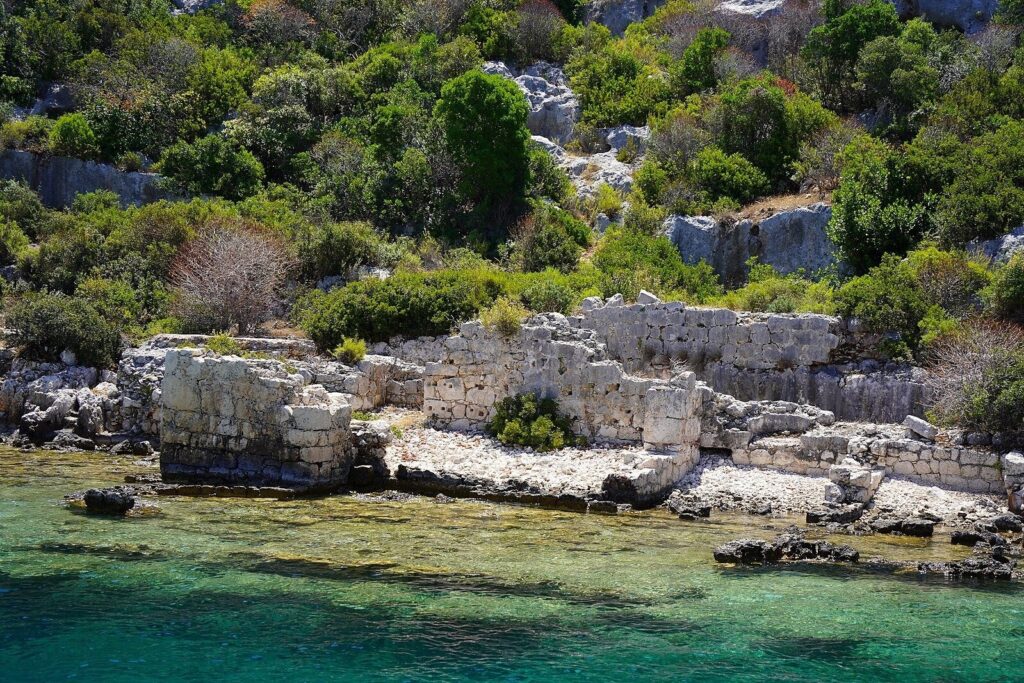In addition to the many magnificent historical monuments in Greece, the country has several unique sunken cities and archaeological sites.
These submerged sites aren’t mere shipwrecks or antiquities but fully submerged settlements once teeming with life. Each sunken “Atlantis” boasts its own rich history, intriguing enthusiasts of the extraordinary.
Several of these sites are accessible for exploration through scuba diving, showcasing historical and scientific treasures now at the bottom of the sea.
Epidaurus, the jewel of the Peloponnese, is famous for its well-preserved ancient theater. One of the most significant archaeological sites of Greece, it attracts thousands of tourists and antiquity lovers. However, not all of the many visitors know about the equally interesting historically valuable landmark.
Nearby lies a remarkable submerged settlement showcasing the remnants of a vast Roman villa from the second century AD. Experts believe this villa was once home to affluent Romans and their servants.
These ruins, situated just six and a half feet below sea level and in proximity to the coast, remain visible, enabling exploration and examination with the appropriate gear. On clear days, the crystalline waters offer glimpses of preserved building foundations, walls, and ancient amphoras.
Pavlopetri, the World’s Oldest Underwater Town
The submerged city of Pavlopetri off the coast of Laconia in the Peloponnese holds the title of the world’s oldest underwater town. The settlement is about five centuries old. Discovered in Vatika Bay, it is a unique representation of an almost fully intact ancient city. The ruins are a complex layout of roads, houses, and burial sites. Protected by UNESCO’s underwater cultural heritage program, the remains are visible at a depth of fourteen feet, providing a remarkable snorkeling experience.
Archaeological studies have revealed intricate urban planning within Pavlopetri complete with intricate road systems, two-story residences, and a sophisticated water management system.
Furthermore, the sunken city’s ruins feature well-preserved stone walls, courtyards, and rectilinear buildings, accompanied by ancient graves. The remnants are evidence of a bustling textile industry and a trading port. This is indicated by the discovery of various loom weights and imported pots from Crete. Geologists attribute the city’s submergence to the local and regional faulting of the Cretan Arc. This led to tectonic plate convergence and subsequent subduction, causing Pavlopetri to sink.
Helike, the Greek Atlantis

While some ancient tales of lost sunken Greek cities such as the Lost City of Atlantis may be nothing more than legend, some of these speak to reality. Helike is a real-life Ancient Greek city that was destroyed, buried, and lost to history by a tsunami. This sunken settlement is located in the northern Peloponnese region of Greece around two kilometers from the Corinthian Gulf.
Helike was not just any ordinary Ancient Greek city. It was a cultural and religious center that held prominence within the Achaean League. The epic poet Homer mentioned Helike’s participation in the Trojan War, highlighting its importance in the ancient world. The city boasted a sanctuary dedicated to the Poseidon Temple, a center of religious worship.
The legend of the lost city of Helike also holds great significance in the context of Plato’s narrative of the lost city of Atlantis. Some scholars speculate that the demise of Helike might have influenced Plato’s tale, given the parallels between the two stories. The destruction of this prosperous city, submerged by natural forces, echoes the mythical narrative of Atlantis.
Helike is said to have met its catastrophic end in 373 BC. Today, it is believed to have been hit by both an earthquake and tsunami. As a result, Helike was left in devastation and submerged.
Dolichiste, the Sunken City of Asia Minor

Dolichiste ( Greek:Δολιχίστη) was an Ancient Greek settlement situated off the Lycian coast within Asia Minor. Now called Kekova, it is part of the contemporary Antalya Province of Turkey. This area was mentioned by geographers such as Stephanus of Byzantium, Pliny, and Ptolemy. It served as a pivotal trading center along the Mediterranean route linking Andriake, Simena, Teimioussa, and Aperlae.
Over time, the region experienced a series of natural and man-made shocks that led to gradual decline and eventual partial flooding of the settlement. Tectonic activities and rising sea levels were among the factors that contributed to the city’s descent into the depths of the sea. Architectural fragments, including moles, quays, rock-cut structures, water channels, and sarcophagi, offer glimpses into the island’s storied past. Submerged artifacts such as amphorae piles and rock-cut channels continue to unveil the historical riches hidden beneath the waves.
According to scholarly studies, the city endured numerous challenges, including conflicts between the Byzantines and Arabs during the sixth and seventh centuries AD. These adversities, coupled with a decline in protection for the region, eventually led to the abandonment of this once-prosperous city.
Source : Greekreporter


